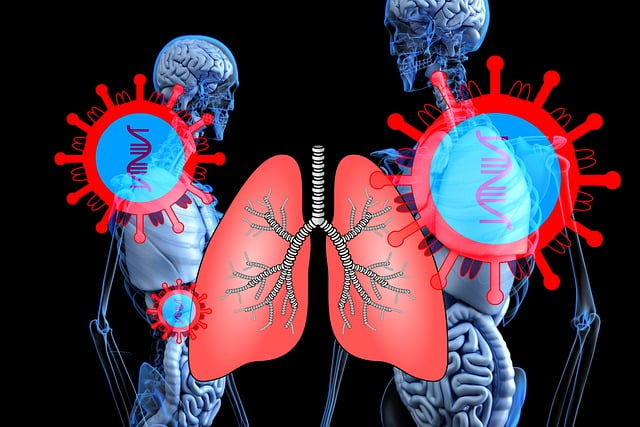Despite recent medical tech advancements, lung and chest imaging struggle with early disease detection due to low contrast between normal and abnormal tissues, especially for subtle changes in early-stage diseases. Traditional methods like X-rays and CT scans have limitations in patient preparation and penetration depth. Current innovations include high-resolution CT (HRCT), molecular imaging, and emerging quantum-based methods to enhance spatial resolution, sensitivity, and specificity. The future of pulmonary imaging is led by artificial intelligence (AI) and advanced CT scanning technologies, promising reduced scan times, improved image quality, and earlier detection of diseases like lung cancer through unprecedented detail and accuracy, ultimately leading to better patient outcomes.
The future of early disease detection in the lungs and chest is bright, thanks to groundbreaking innovations in pulmonary imaging technology. Current limitations of traditional techniques like X-rays and CT scans highlight the need for advanced solutions. This article explores emerging technologies such as high-resolution CT scans, artificial intelligence (AI), and quantum imaging, delving into their advantages for improved diagnosis and personalized treatment. We also discuss ethical considerations and future directions, emphasizing the importance of privacy, cost-effectiveness, and standardized protocols in integrating these game-changing pulmonary imaging innovations.
Current Limitations of Lung and Chest Imaging
Despite significant advancements in medical technology, lung and chest imaging still face several limitations that hinder early disease detection. Traditional methods like X-rays and CT scans offer valuable insights but struggle with low contrast between normal and abnormal tissues, especially for subtle changes associated with early-stage diseases. This issue is particularly challenging in the pulmonary imaging domain, where small anomalies may go unnoticed amidst the complex lung structure.
Additionally, current imaging techniques often rely heavily on patient preparation, such as the administration of contrast agents or specific breathing maneuvers, which can be invasive and uncomfortable for patients. The limited penetration depth of these methods also restricts their ability to visualize deep lung regions, further complicating the early detection of diseases affecting peripheral areas. As a result, there is an urgent need for innovative pulmonary imaging technologies that surpass these current limitations.
– Discussion on existing techniques and their shortcomings.
Current lung and chest imaging technologies, such as X-rays, computed tomography (CT), and magnetic resonance imaging (MRI), have significantly advanced our ability to detect and diagnose pulmonary diseases. However, each has its limitations. X-rays, while widely accessible, struggle with low contrast resolution, making early-stage tumors or subtle inflammation challenging to discern. CT scans offer better detail but come with higher radiation exposure and can still miss small lesions or overlap with normal structures. MRI provides excellent soft tissue contrast but is less feasible for routine screening due to its lengthy acquisition times and cost.
These shortcomings drive the need for future innovations in pulmonary imaging. Researchers are exploring advanced modalities like high-resolution CT (HRCT) with its improved spatial resolution, molecular imaging techniques like positron emission tomography (PET) for targeted lesion detection, and even quantum-based imaging methods promising unprecedented sensitivity and specificity. The goal is to achieve earlier, more accurate disease detection, ultimately improving patient outcomes.
Emerging Technologies for Pulmonary Imaging
The future of pulmonary imaging is brimming with exciting innovations, promising earlier and more accurate disease detection within the lungs and chest. Technologies such as artificial intelligence (AI) and advanced computed tomography (CT) scanning are at the forefront of this revolution. AI-driven systems can analyze vast amounts of medical data to identify patterns indicative of diseases like lung cancer at their earliest stages. Meanwhile, high-resolution CT scanners offer unprecedented detail, enabling healthcare professionals to spot subtle anomalies that might be missed by conventional methods.
Additionally, quantum computing is poised to enhance pulmonary imaging capabilities further, potentially reducing scan times and improving image quality. These emerging technologies collectively aim to transform diagnostic processes, leading to more effective treatment strategies and improved patient outcomes in the field of pulmonology.
– Overview of cutting-edge technologies like high-resolution CT scans, artificial intelligence (AI), and quantum imaging.
The future of pulmonary imaging is poised for a significant transformation with the advent of cutting-edge technologies. High-resolution CT (computed tomography) scans have already shown remarkable potential in detecting subtle changes within the lungs, providing earlier insights into diseases like cancer and chronic obstructive pulmonary disease (COPD). These advanced scanners offer unprecedented detail, allowing radiologists to identify even the tiniest anomalies that might be missed with conventional methods.
Artificial intelligence (AI), another revolutionary force, is being integrated into pulmonary imaging to enhance accuracy and efficiency. AI algorithms can analyze vast amounts of medical data, learn from patterns, and assist in detecting diseases at their earliest stages. Quantum imaging, a relatively newer concept, explores the principles of quantum mechanics to create even higher-resolution images, pushing the boundaries of what’s possible in lung and chest imaging. These innovations collectively promise more accurate diagnoses, personalized treatment plans, and ultimately, better patient outcomes.
The future of early disease detection in lung and chest conditions looks promising with emerging pulmonary imaging technologies. Overcoming current limitations through advancements in high-resolution CT scans, artificial intelligence, and quantum imaging holds the key to more accurate and efficient diagnostics. These innovative approaches have the potential to revolutionize healthcare by enabling prompt treatment and improved patient outcomes, ultimately transforming the way we navigate lung health.
